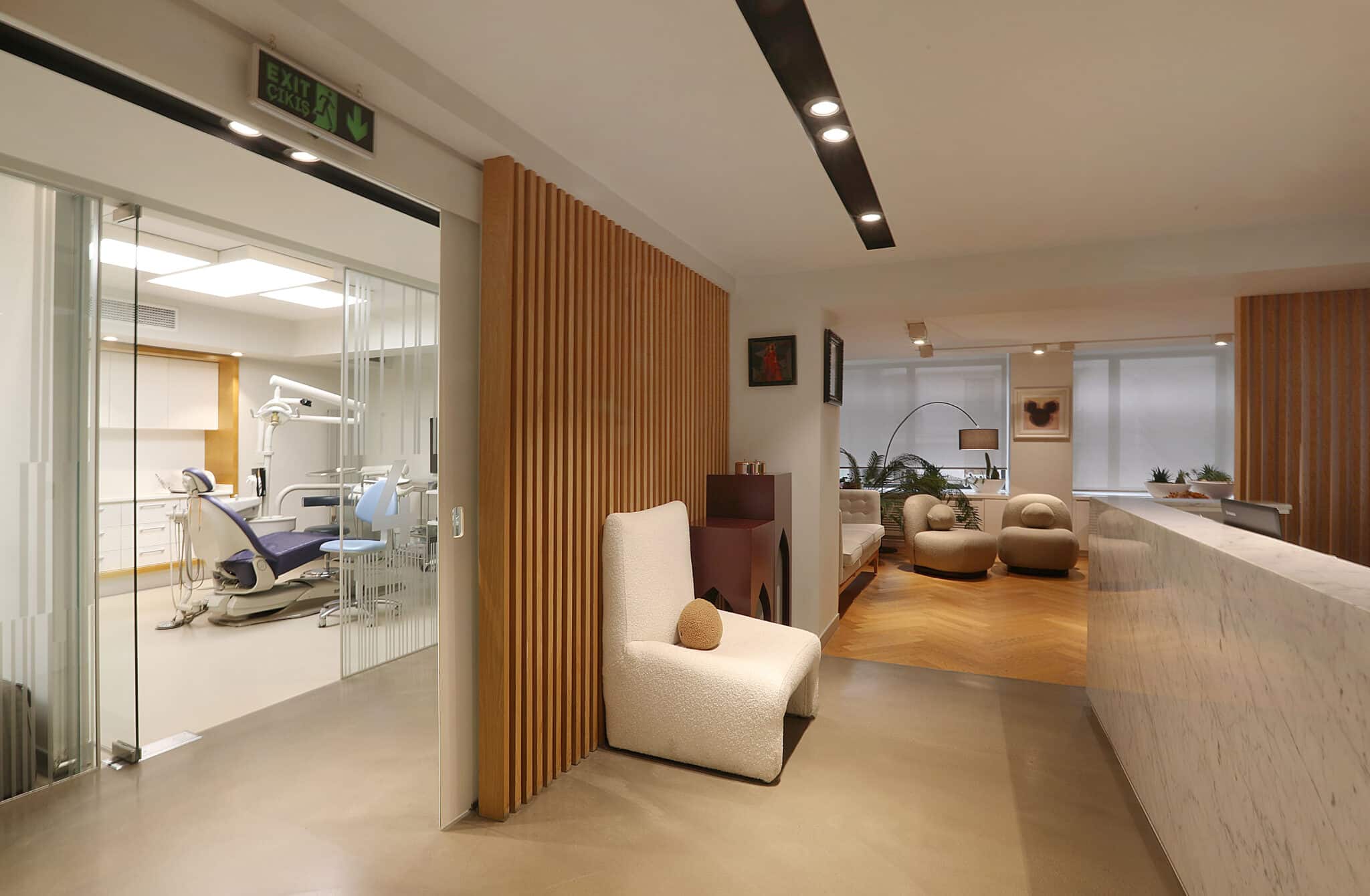Small Changes Make a Big Difference
At Creadenta, we take pride in providing you with comprehensive and personalised dental care. Our founding partners, with their more than 30 years of experience in their field, oversee all aspects of your treatment, ensuring that every plan is customised just for your needs and supported by highly skilled and experienced specialists.
- Porcelain Laminate Veneer
- Smile Design
- Porcelain Crowns And Bridges
- Zirconium
- Porcelain Fillings (Inlay-Onlay)
- Gum Line Re-Contouring
- Gingival Melanin Pigmentation
- Composite Fillings (Bonding)
- Icon Filling
- Teeth Whitening
- Root Canal Treatment
- Invisalign
- Gummy Smile
- İmplant
- Bone And Tissue Regeneration (Grafts)
- Sinüs Lifting
- Gum (Periodontal) Treatment
- Bite, Teeth Grinding (Bruxism) And Joint Problems
- Porcelain Laminate Veneer
Porcelain veneers are custom-made thin shells applied to the tooth front (facial) surface. It is one of the most conservative treatments, if the procedure is applied correctly. Since it is thin, it looks very aesthetic and natural. It can be thinned to 0.1-0.3 mm in many cases. (This is a very technical procedure and requires the doctors and ceramists to be highly skilled and have lots of experience –
We have been teaching hands-on-courses and seminars, about this technique, to our colleagues for many years.)
Porcelain veneers are semi-translucent, meaning light partially passes through them and acts like a natural tooth structure. This light transmittance however depends on the porcelain used, and the technique applied.
Only a small amount of tissue should be removed, for the procedure to be healthy.
Please remember that veneer treatment is an add-on treatment procedure.
It is essential to protect the enamel, the top layer of the tooth. If the tooth is over-prepared and the enamel layer is removed, the stiffness and thus the strength of the tooth decreases. This is very important as enamel protects the tooth structure against any trauma.
It is wrong to prepare a previously unprepared tooth and make a crown for aesthetic reasons. It is then impossible to regain this lost enamel layer.
Staying in enamel as much as possible is important.
If preparation is required to provide space for the porcelain to destroy the enamel of your teeth and expose a large amount of dentin, the correct thing to do is to first adjust the position of the teeth with orthodontic treatment.
We will only do crown preparation if the tooth has previously been prepared.
We try to preserve the enamel as much as possible.
During the initial consultation, a mock-up can be applied to your teeth without touching them, allowing you to see a 3D representation of what your smile could look like. This application gives you an initial idea of your new smile.

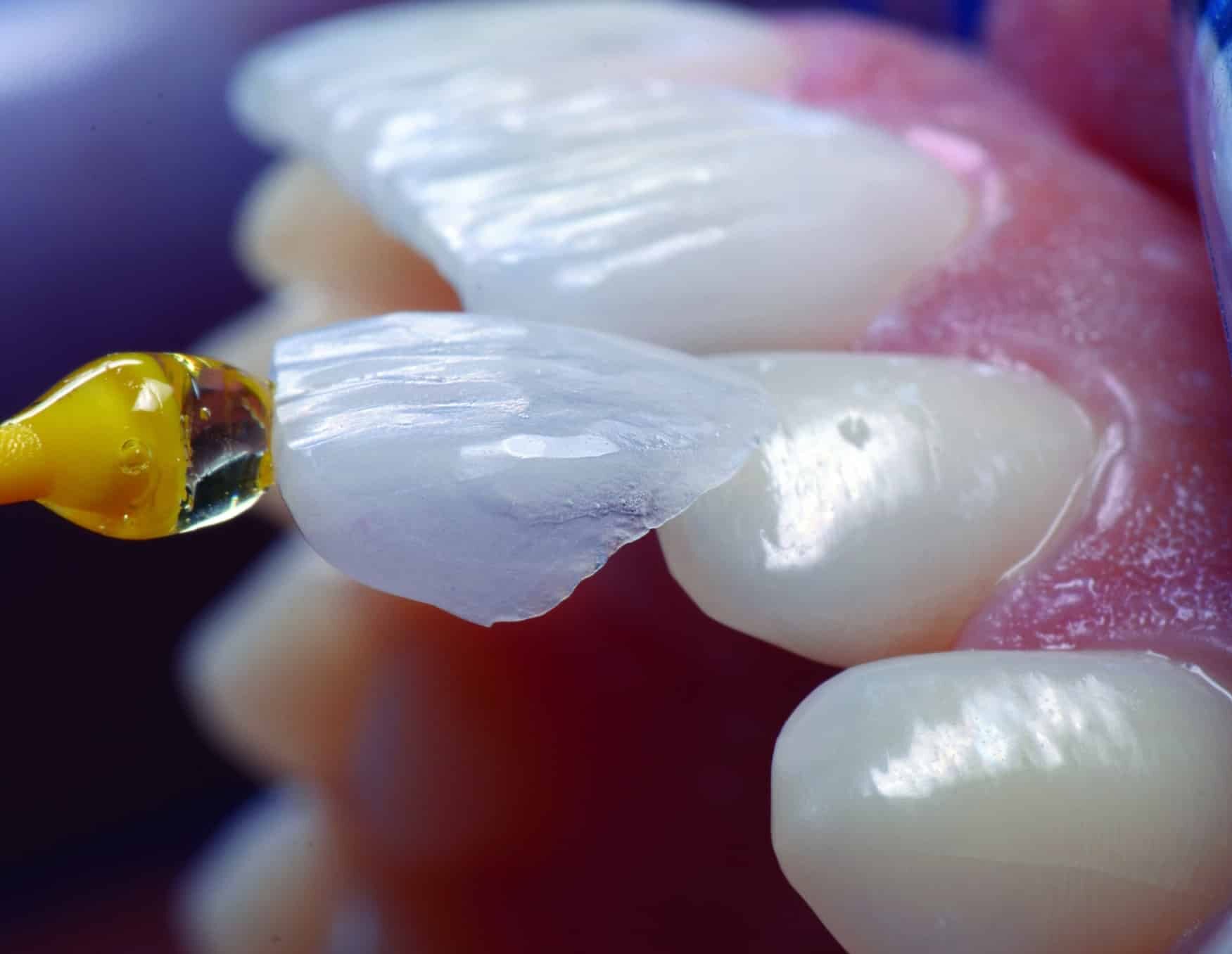
Advantages of Porcelain Veneer Treatment:
- Porcelain veneers are minimally invasive and one of the most conservative (protective) treatment options that can be performed for aesthetic purposes. This is because, using this technique, very little tissue needs to be removed (typically 0.1-0.2mm). In fact sometimes, the tooth may not need to be touched at all. A brand-new smile can be achieved in around 2-3 appointments if there are no underlying gum issues.
- It is impossible for decay to occur under a surface covered by the porcelain veneer. Any decay that may occur on the uncovered tooth surfaces can be easily diagnosed and treated while porcelain veneers are in place.
- The translucent nature of porcelain veneers allows for a natural appearance that is indistinguishable from natural teeth. The more light transmission properties a veneer has, the more natural the result will be.
- If all the rules of the procedure are applied properly, the accumulation of bacterial plaque and tartar on the surface of porcelain veneers becomes very difficult.
- Porcelain veneers do not change color with external factors such as coffee, tea, or tobacco.
- Although the porcelain veneer material is very fragile to touch, when properly bonded to the enamel, they are highly durable, and resistant to wear. For example, it is not possible to remove a bonded veneer from the tooth like a crown, it can be only removed away from the tooth surface with diamond burs or a laser.
- Since the tooth is not completely covered by veneers unlike crown/ bridge restorations, the protective layer of the tooth (the enamel) is preserved. This means the tooth will have no sensitivity or pulpal damage and will maintain perfect mechanical properties. It is important to remember, though, if the enamel layer is moved, the stiffness and strength of the tooth will decrease. The enamel protects the tooth structure against any trauma.

- Smile Design
Smile design is the process of planning and creating a customised smile that combines your personal preferences with health, naturalness, and function. The key is to create teeth that perfectly blend with the individual’s face and are not immediately noticeable to others, too large, too white, or too prominent.
In a poorly executed treatment, the porcelain will be easily noticeable, and the teeth that immediately catch the viewer’s attention will be not in balance with the face and smile.
Your smile says a lot about you. According to research, when people first meet, they usually look at your smile. In an unbalanced smile, your eyes immediately focus on the person’s teeth, and subconsciously, you try to find the reason for the problem in their smile. We all do this, it’s part of our social nature. In a harmonious smile, your brain registers that the person has a pleasant smile and directs your attention to their eyes. Nothing expresses personality, energy, and confidence as much as a healthy and radiant smile.
During the first consultation, we apply a model without touching your teeth. so you can see a 3D representation of what your smile might look like. This application gives you an initial idea ofyour new smile.
Your smile is our passion
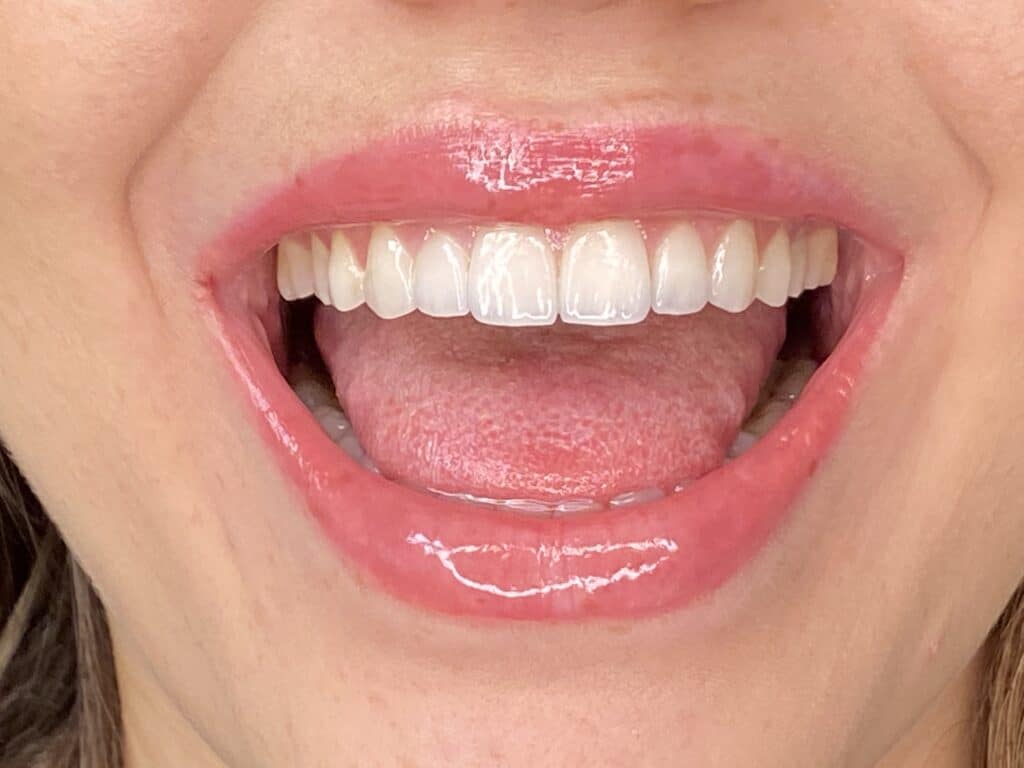
Orthodontic treatment is the process of aligning a patient’s dentition and occlusion by using various orthodontic techniques. These techniques may include the use of traditional metal or porcelain brackets, lingual brackets and clear aligner therapy. Additionally, orthodontic treatment can involve pre-treatment alignment of teeth to optimise the positioning for future restorative procedures, such as laminate veneers, resulting in a more aesthetic, preservative and functional outcome.
Thin porcelain veneers bonded to your teeth can create significant changes. This is the most widely used technique in aesthetic dentistry because it allows for the redesign of a smile with minimal to no reduction of tooth structure. Due to their translucency, they can not be distinguished from natural teeth.
This treatment enables your teeth to have a whiter and more radiant natural colour. It is one of the most conservative treatments that can eliminate discolouration and stains caused by trauma, ageing and various medication.
This treatment is used to repair minor cavities, fractures, and defects in teeth. It is composed of advanced, enamel-matching materials. It is a cost-effective and easy-to-apply treatment, although its durability is limited to the size and position of the cavity, oral hygiene and the habits of the patient.
Metal-free Porcelain Crowns and Bridges : They are applied to severely damaged or previously extracted teeth with the aim of improving both appearance and health.
We only apply the crown or bridges, if the tooth has already been prepared by another dentist.
Preserving healthy tooth structure is one of the most important principles of modern dentistry. The destruction of the entire enamel, or even more of the tooth structure, for cosmetic purposes can create significantly greater problems than benefits. It can even result in the eventual loss of the tooth in the long run.
Cosmetic contouring involves shaping teeth with minor abrasions on the enamel and adding small composite bonding ( without reduction) to create a more symmetrical and properly aligned appearance.
Asymmetry, excessive gingival display and gingival recession can disrupt the harmony of a smile. In such cases, minor adjustments can be made to achieve gingival aesthetics. While simple reshaping procedures are often sufficient, more complex cases may require surgical intervention that involves removing excess bone and promoting gingival reattachment.
- Porcelain Crowns and Bridges
Metal-free full porcelain crowns or bridges are applied to damaged or previously extracted teeth with the aim of improving both appearance and health. We prefer to only perform tooth reduction for this application on teeth that have been previously reduced for the purpose of placing a crown.
Preserving healthy dental tissue is one of the most important principles of modern dentistry.
Among the numerous factors affecting the appearance of crowns, the most important one is their reaction to light. Natural teeth are translucent, creating a deep and vivid image. Because of their light-transmitting properties, metal-free porcelain crowns (full porcelain) have greater depth and vitality, which produces a result far more similar to natural teeth.
Thanks to their translucency, full porcelain crowns create a very natural aesthetic appearance that is highly similar to natural teeth, whereas metal porcelain crowns can have a dull and artificial appearance. Therefore, full porcelain crowns are preferred especially in the anterior teeth.
Metal-supported porcelain crowns can create an opaque and dull appearance in the mouth under certain types of light. However, full porcelain crowns transmit all types of light just like natural teeth. Metal-supported porcelain crowns are mechanically bonded to the tooth whereas full porcelain crowns are attached both mechanically and chemically making them much more stable than metal-supported ones.
Metal-free crowns do not create a dark line at the crown-gum junction, which creates a more aesthetic appearance. Full porcelain crowns preserve their aesthetic appearance when gum recession occurs, while metal porcelain crowns have a poorer appearance at the junction with the tooth and the gum. Full porcelain crowns do not create any risk of allergy unlike metal porcelain crowns that may have certain metals as a substructure, such as nickel.
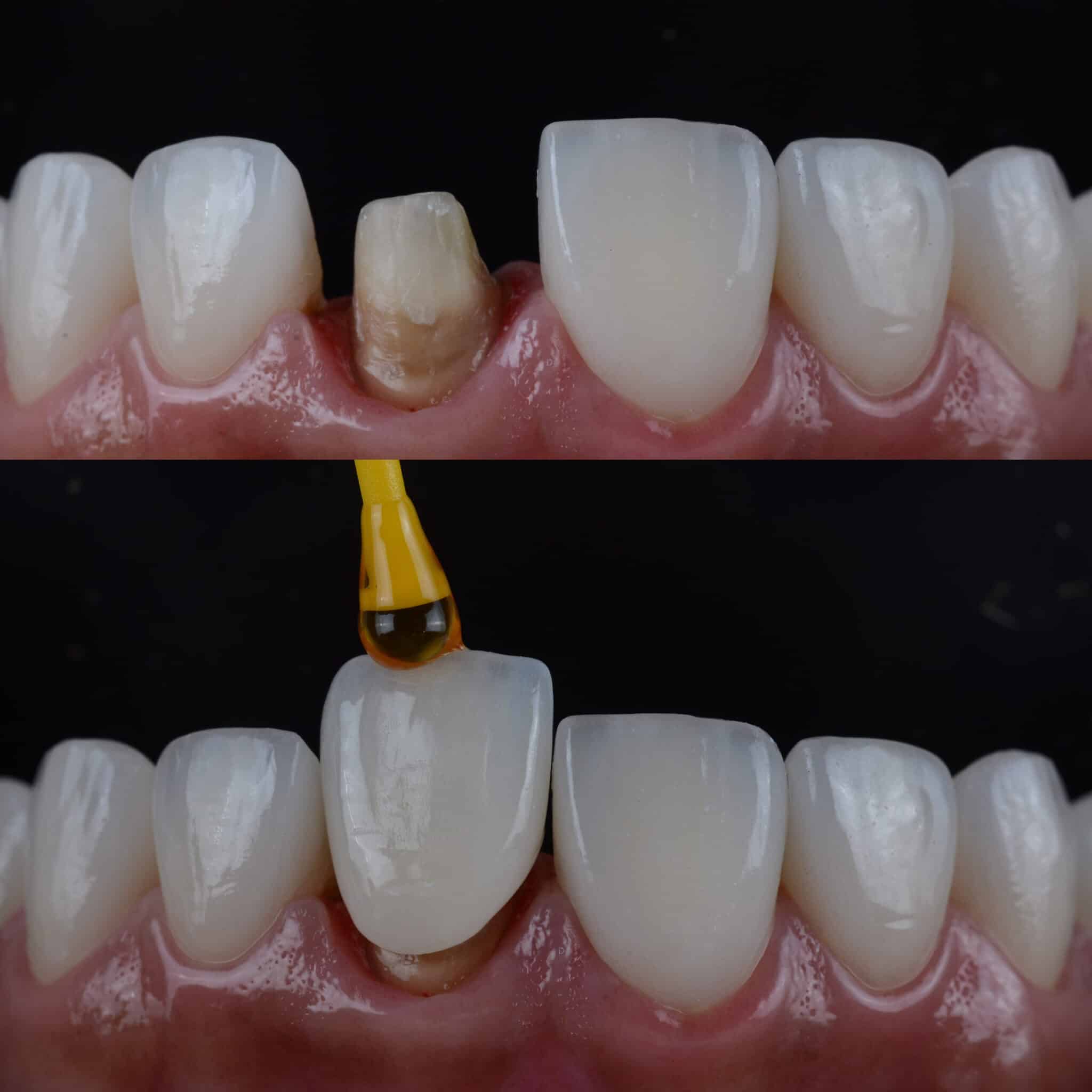
- Zirconium
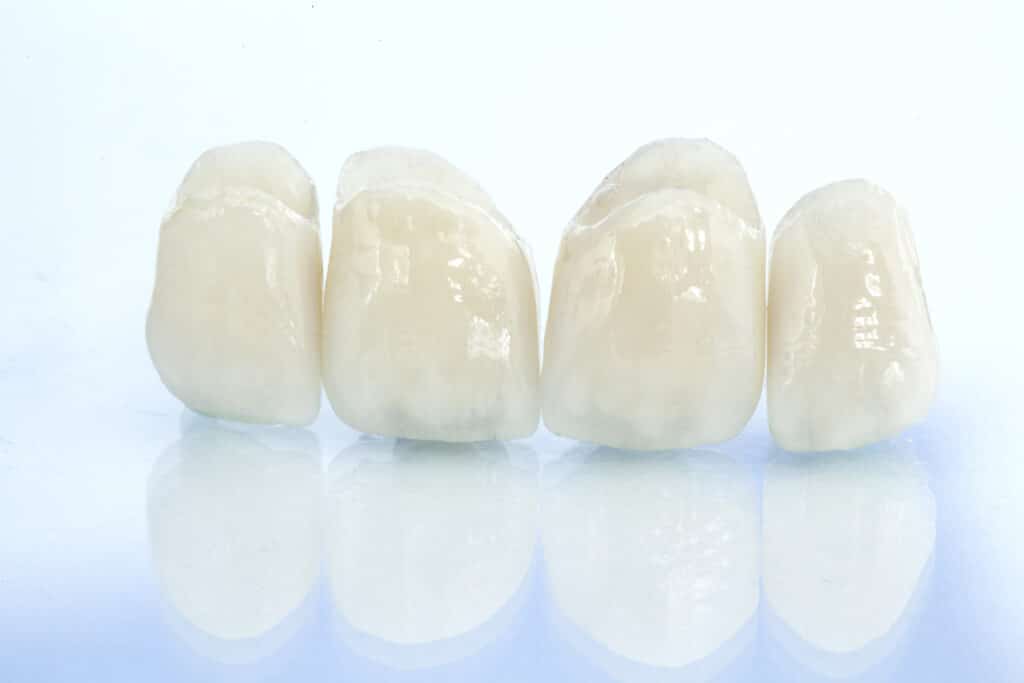
Metal-free, Zirconia-based crown and Bridges
To improve both appearance and health, Zirconia-based crown and bridge are applied to heavily damaged or previously extracted teeth. For this procedure, we prefer to only reduce tooth structures that have already been prepared for crowns. In light of current knowledge, preserving the healthy tissue of teeth should be one of the most important guiding principles of dentistry.
In this system, zirconium, a white alloy, is used as the infrastructure instead of metal. This state-of-the-art substrate material offers both aesthetics and durability. The main advantage of the system is that it provides a fully aesthetic appearance even in posterior bridges, thanks to its superior durability.
Traditionally, a metal substructure has been used under the porcelain for enhanced durability of porcelain applications. However, due to the drawbacks of metal in terms of gingiva and tooth tissue, overall health, and most importantly aesthetics, an alternative search to metal has been ongoing for years in porcelain substructures. Zirconium is the result of this research.
The application of zirconium as a substitute for porcelain metal, which has been successfully used in other disciplines of medicine, has opened a new era for dentistry.
Today, some changes are being made to the structure of zirconium to make it more transparent and natural-looking. The results have been very successful.
- Porcelain Fillings (Inlay-Onlay)
Porcelain fillings are preferred in cases where the loss of dental tissue is profound and composite fillings are insufficient for long-term success.
Porcelain fillings, which are fabricated in harmony with the shade and shape of the teeth of the patient, are significantly advantageous to composite fillings because they preserve the natural form and appearance of the tooth.
They are especially applied to molars.
The tooth preparation is done and impressions are taken during the first visit. Porcelain fillings produced by the laboratory are applied to the patient in a second session. Porcelain fillings have a more durable structure and a more finishing line than composite fillings. Porcelain fillings are the most suitable material for intraoral restoration in the world.
Advanced technology is used in the production of porcelain fillings.
The porcelain filling is a method that preserves the healthy dental tissue in the mouth while achieving maximum adherence with minimal material loss. Since they are made from special compressed glass porcelain that does not polymerize in the mouth, leakage is minimal. This prevents decay under the filling . The material of porcelain fillings is similar in hardness to a tooth and is thus harmonious with the gum tissue.
They do not abrade the teeth like other porcelains when polished well and do not wear down in the mouth like composite fillings.
Porcelain fillings are preferable over composite fillings or crowns, especially in cases of excessive dental tissue loss. Porcelain fillings are an ideal and protective treatment option.
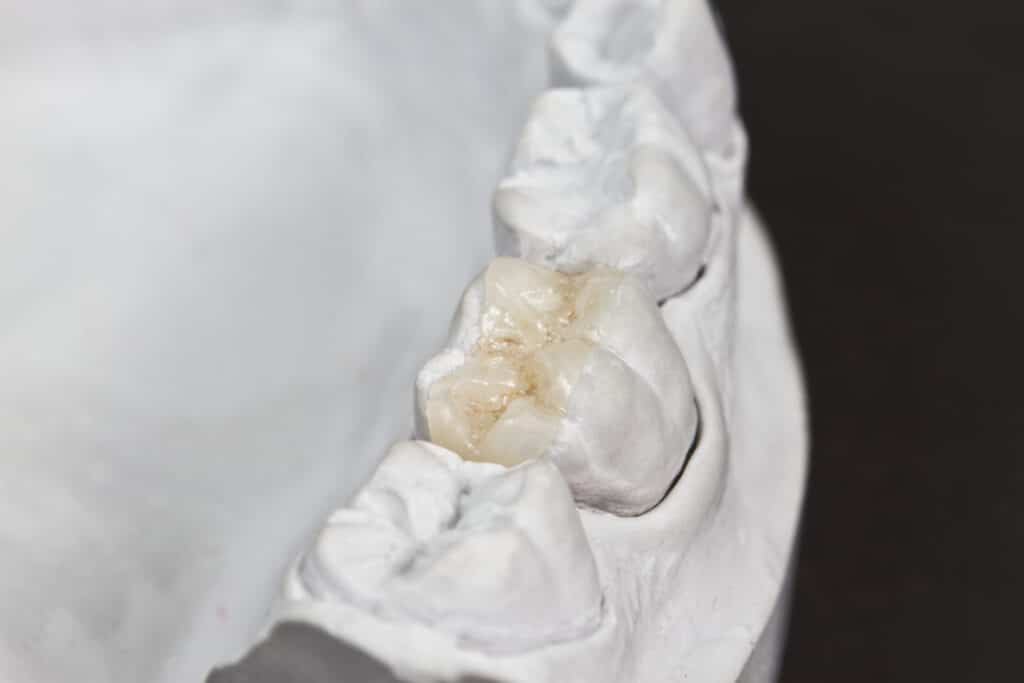

- Gum Line Re-contouring
Gingival Recession
When a gingival recession occurs, some teeth may seem longer than others due to exposure to their root surfaces. In such cases, the first step must be the gingival treatment and exposed surfaces must be covered with soft-tissue grafts.
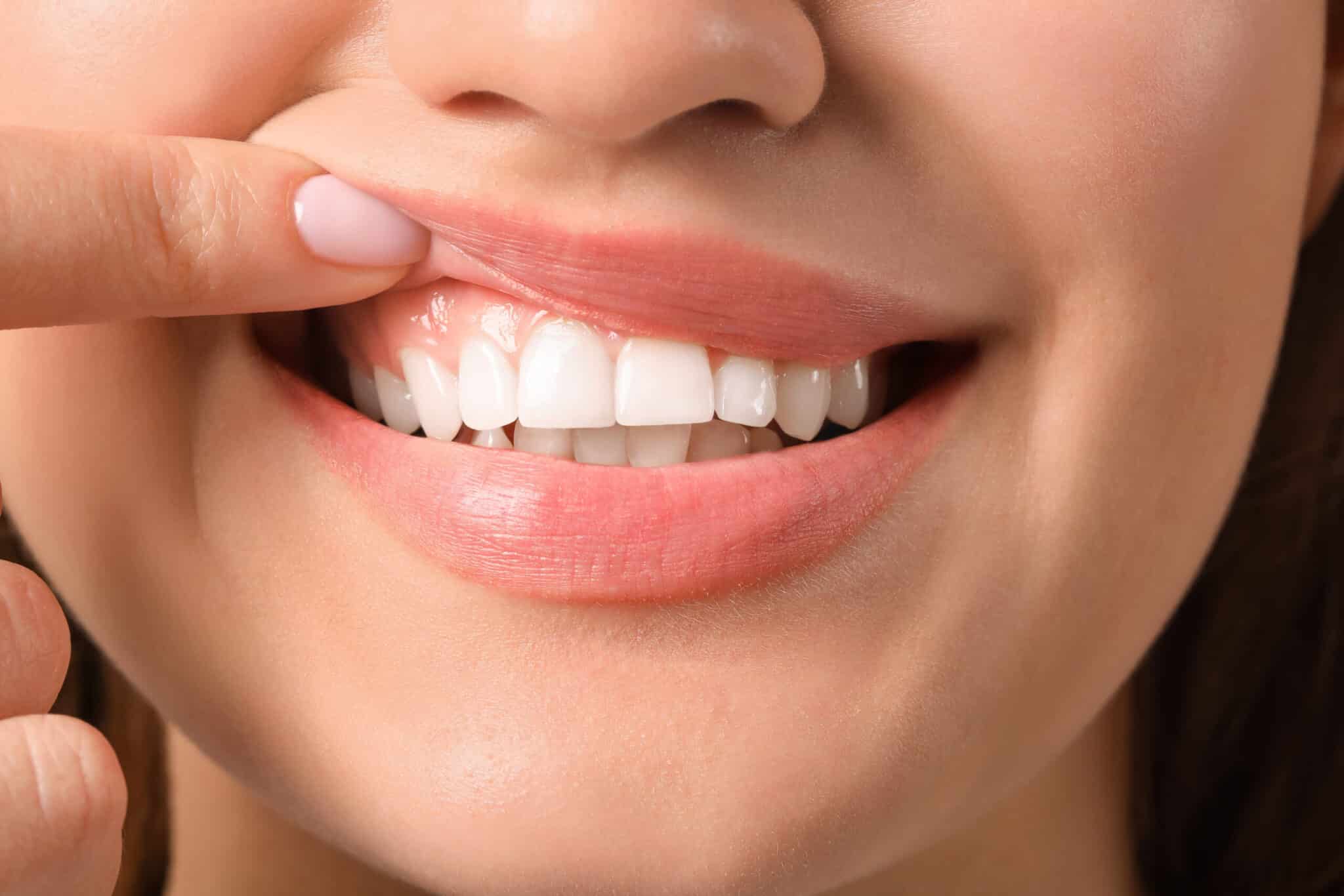
Irregular Gingival Margins (Reshaping Gum)
The gum tissue surrounding the teeth might be too high or too low on some teeth due to gingival recession, malocclusion, or defects caused by tooth loss.
The gum shape must be restored to its ideal shape before any aesthetic procedures are performed.
Irregular gingival margins can be restored without violating the biological width, by taking advantage of hemostasis as well as simplified surgical procedures, thanks to electrocautery and lasers. Since an important part of aesthetics is having ideal forms of the gum tissue surrounding the teeth, these minor adjustments will result in a much more successful outcome.
Crown Lengthening Surgery
Crown lengthening is a procedure performed to elongate the portion of the teeth (visible part in the mouth) that are above the gingival margin level. In some cases, the cavity or fractures may progress below the gum line, or the teeth may be too short, requiring them to be elongated. In some cases, when a patient smiles, their gums may appear excessively prominent and in such cases, to ensure the luting of prosthetic treatments (such as crowns, bridges etc.), gum tissues must be extended towards the root portion of the teeth for gum health and aesthetics.
- Gingival Melanin Pigmentation
Typically, healthy gum tissue appears pink in colour and orange peel texture. However, individuals who have a genetic predisposition or who smoke excessively may develop dark brown or black spots on their gums due to an excess of melanin pigment.
Even though there is no harm to one’s health, blemishes that may cause aesthetic discomfort can be eliminated by the “peeling” method. The ideal aesthetic for teeth is characterized by the proper alignment of teeth on healthy-looking pink gums. As a result, the presence of a different colour in the gums prevents the achievement of ideal asthetics.
A similar process to the skin peeling procedure performed by dermatologists on the face, this procedure can be applied intraorally in areas discoloured by stains. Intraoral skin is also composed of layers, and by slowly and carefully thinning and peeling these layers, gradually the discoloured uppermost layer will be removed to reveal a far a more aesthetic appearance.
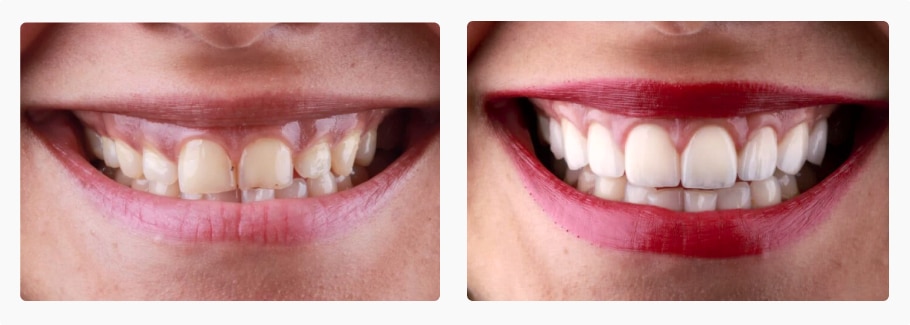
- Composite Fillings (Bonding)
Composite filling – which is used to repair and restore teeth that have decayed, fractured or deformed – eliminates aesthetic concerns with its natural tooth shade colour. It has been successfully applied to both front and back teeth.
These fillings are placed layer by layer into prepared cavities and each layer is hardened with a special polymerization light. They are both aesthetic and cost-effective. As they can adhere to the tooth by a special bonding agent, they do not cause an unnecessary loss of dental tissue. Although there may be a slight shrinkage during hardening, their lifespan is not as long as porcelain fillings. However, composite fillings are still recommended for cases where there is not much damage to the teeth.

- Icon Filling
Icon Filling is a treatment method used to eliminate opaque white/brownish stains on teeth (such as discolouration caused by previous medication ) without creating any cavities. This highly specialised technique involves infusing resin into the tooth, strengthening the enamel in problem areas, correcting colour, and even eliminating areas prone to decay.
Icon filling is particularly used for front teeth and is a protective treatment. Today, the problems we commonly encounter that cause discomfort both aesthetically and in terms of health are addressed through this new technology, which imitates the natural enamel of the tooth without causing any substantial loss to the tooth.
While it may not be 100% successful in every case (depending on the depth of the problem and the intensity of the colour difference), it has great benefits in that it strengthens the weakened enamel and eliminates the unesthetic color in that area of the tooth.
- Teeth Whitening
Teeth whitening is a method of oxygenation, used to whiten discoloured teeth for various reasons or to lighten the natural tooth colour by a few shades.
The natural colour of teeth could be dark or could darken over time due to external factors. A teeth whitening procedure can be performed at the dental clinic or at home to achieve a satisfactory whitening result by 2-5 shades. However, each tooth colour may not lighten to the same level. Similarly, thin enamel teeth and older individuals may experience less whitening during the process. The bleaching procedure must always be performed under professional supervision.
Are Your Teeth Suitable for Whitening?
The level of teeth whitening primarily depends on their initial colour. Yellow-toned teeth can easily lighten by 2-5 shades, whereas whitening green-grey-toned teeth can be more difficult. Teeth whitening results are typically more satisfactory in younger patients due to the thicker and healthier enamel. However, in older patients, the amount of whitening is usually less.
Sensitivity
It is normal to experience some sensitivity as a result of teeth whitening procedure, depending on the nature of your teeth. Patients with abraded or cracked enameled teeth might experience more sensitivity.
This sensitivity can be relieved by a light painkiller.
Some level of sensitivity is normal in a teeth whitening treatment, depending on the structure of the tooth. Patients with abraded or cracked enamel teeth may experience more sensitivity. If sensitivity occurs, it can be relieved with a mild painkiller. If during your initial examination, your dentist determines that your enamel is not suitable for this procedure, they will not recommend whitening to you.
Durability and Reliability
The results obtained from teeth whitening are long-lasting, but the duration may vary depending on the patient. Excessive smoking, as well as consumption of coloured foods such as tea, coffee, and cola, might have an adverse effect on the duration of the results as an extrensic stain. You should also avoid hot/cold drinks and foods, as well as coloured agents such as cigarettes, coffee, tea, cola, and red wine, for up to 24 hours after the treatment.
The light and gel used in teeth whitening, which have been discovered through many years of research, are completely safe.
Teeth whitening is a procedure that should not be repeated frequently.

The whitening process takes approximately one hour, with the dentist applying the whitening gel and then activating it with the light source.
We use Philip’s Zoom Whitening System
The Zoom whitening system can only be used by specially trained and certified dental professionals. You cannot have this procedure done at beauty salons.
During the treatment:
-After applying the special retractor, your gum tissue is protected with the special barrier material.
-Your teeth are then coated with the whitening agent and the Zoom light is used to activate the gel
-With three or four 15-minute slots of light application, your whitening process will be completed within one hour.
The advantage of the office-type whitening is that the entire procedure is fully supervised by your dentist.
Home bleaching is a teeth whitening procedure that involves placing carbamide peroxide based gels into custom-made plastic mouth trays that are made from a simple impression of the patient’s mouth. The desired whitening is usually achieved within an average of five to seven days, depending on the type of gel and the shade of the teeth.
The trays need to be worn for four to eight hours per day, depending on the gel concentration.
During these five to seven days, it is important to avoid colouring agents as much as possible (such as tea, coffee, cigarettes, red wine, mouthwashes, etc.). Since there is no control by the dentist in home bleaching, it is important to listen to and follow the instructions given regarding the procedure.
Home bleaching is sometimes recommended to support office bleaching.
- Root Canal Treatment (Endodontic Treatment)
Root canal treatment, also known as endodontic treatment, is performed when the pulp (the core of the tooth) – which is a bundle of blood vessels and nerves responsible for the tooth’s vitality and nutrition – is damaged, irreversibly compromised, infected, or loses its vitality (necrosis).
Root canal treatment is recommended in cases of pain whilst biting or chewing, severe hot-cold sensitivity, tooth abscesses, and when teeth have been damaged and discoloured due to trauma.
The treatment involves the removal of infected or necrotic pulp from the tooth’s root canals, cleaning, shaping, sterilising, and filling the canals with biocompatible filling materials.
After the root canal treatment, there may be mild sensitivity or pain during chewing, this is a normal discomfort and a temporary experience.
If root canal treatment is delayed, damage may occur in the bone supporting the tooth of the root and surrounding areas. This could lead to problems that may require surgical intervention or tooth extraction.
We provide high-quality root canal treatments carried out by our expert endodontist. Our endodontist is highly experienced professional, who has been practicing since 1996, and has worked on many complex cases.
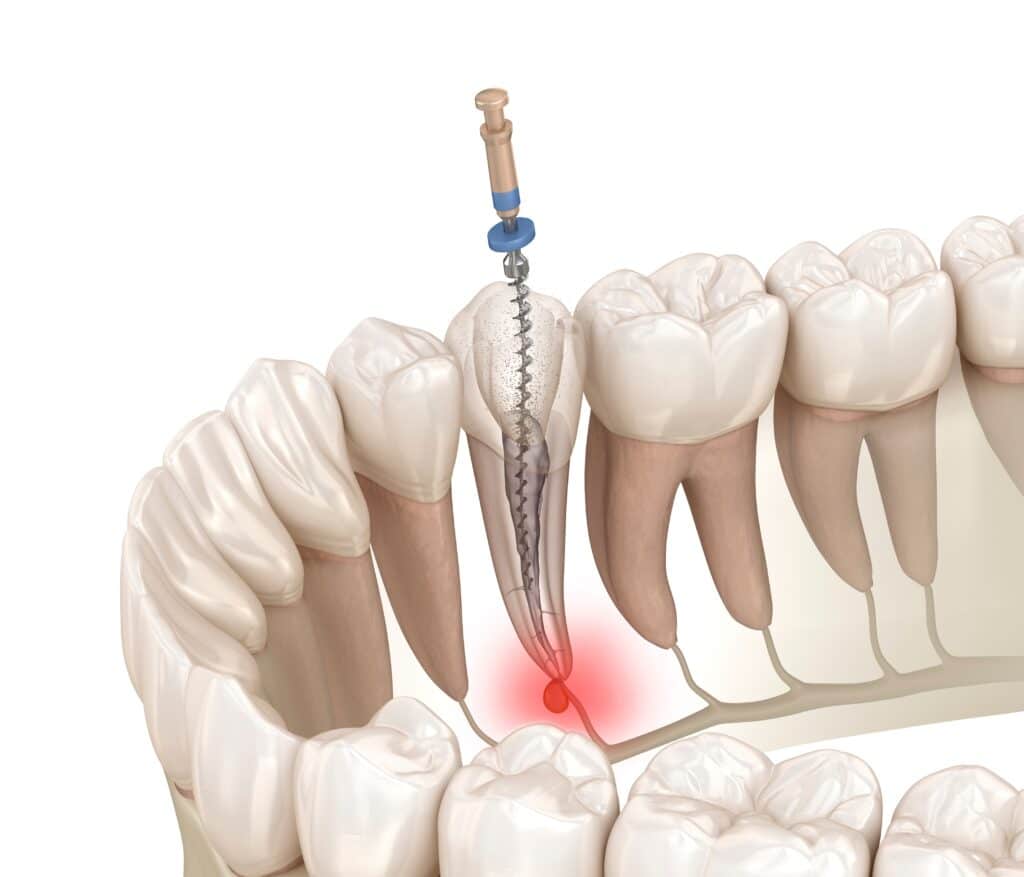
- Invisalign
Invisalign
Invisalign is currently one of the most commonly used orthodontic treatment techniques.
Invisalign gently correct the levelling of the teeth by using series of clear removable aligners that are custom-made specifically for your teeth.
In this method, the treatment is planned using 3D digital technologies by our orthodontist who has the invisalign certificate. We will be able to predict the expected tooth movement from the initial to potential final result position, together with you.
During this treatment, we may need to place small tooth-colored composite on your teeth to help with tooth movements. At the end of the treatment, these additions can be easily removed without causing any harm to the teeth. We might also need to apply some minor inter-proksimal re-contouring to create space to allow tooth movement to occur.
You should wear your aligners for up to 22 hours a day (you should only take them off to eat and brush your teeth) and change the aligners every 10 days with your next set.
Invisalign aligner results are usually noticeable after six months.

- Gummy Smile
A gummy smile, also known as excessive gingival display, is a kind of esthetic problem that patients complain about too much gum tissue is visible when they smile.
Gum aesthetics is one of the most important components of esthetic dentistry. A smile is beautiful only when the teeth and gums are in harmony.
A gummy smile can be caused by variety of reasons, such as teeth that have not fully erupted, an overgrowth of the upper jaw, or the lip rising too far when smiling (hypermobil lip).
The problem that causes the gummy smile must be correctly identified, and appropriate treatment must be performed. Not every case can be treated by removing and lifting the gum tissue.
In simple cases, the gum tissue can be re-shaped to achieve the desired result. However, in more advanced cases, it may be necessary to remove a small amount of bone beneath the gum tissue. If the need for bone removal is not correctly identified in cases where only the gum tissue is shaped, the gum tissue will quickly return to its previous position. We can also help the end result of a gummy smile treatment by giving the lip more volume.
Hypermobile Lip Plastic Surgery (Lip Repositioning)
The appearance of the gum tissue is directly related to the movement, tone, and thickness of the lips. In some individuals, when they smile extensively, widely, the lip muscle rises so much that the excessive gum tissue becomes visible. In this case, a gum specialist can prevent the lip from rising too high by reducing the depth of the sulcus between the inside of the lip and the gum tissue. This operation limits the movement of upper lip muscles and thus inhibiting it from rising any higher than normal.
Hypermobile Lip Surgery is performed in one to two hours, under local anesthesia by our periodontist.

- Implant
Dental Implants are artificial dental roots made of titanium, that are surgically placed in the jawbone.
Titanium is a tissue-friendly material specially designed and treated to allow the jawbone to fuse to the surface.
It is important the height and width of the jawbone can accomodate the size of the implant.
The height and width of the jawbone should be adequate to accommodate the implant. Otherwise, necessary operations (sinus lifting, graft, membrane use, etc.) can be performed to optimize the implant site. The quality of the jaw bone is an important factor in affecting the performance of the implant. When we apply implants, we always consider how we can minimize bone loss and improve lost bone and gum tissue as well as the tooth for long-term stability.
The success of the treatment depends on high quality implants and the expertise of the dentist.
We use selected brands such as ITI Straumann (Switzerland), Nobel Biocare (Switzerland), MIS(Israel). All of them are very well-known brands worldwide and common across the market. It means if you need to replace the prosthesis part, they are easily accesible worldwide. It will be easy for you or your dentist to find the necessary accessories for the implants, wherever you are in the world. These brands have proven their quality in the field of dentistry.
Dental implant placement requires a great deal of experience and knowledge. Our implantologist has more than 27 years of experience in providing dental implant treatment and treating problems associated with previous implants and complex cases.
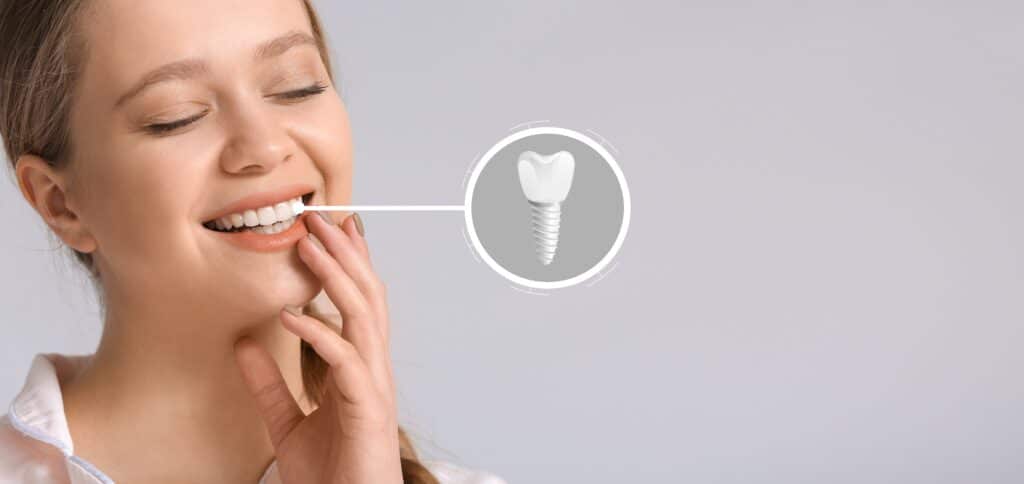
Following the implant placement, it will take several months for the patient’s natural bone to fuse with the implant. This bone fusion process is known as osseointegration and allows the implant to fix itself very tightly to the jaw.
After the healing process of the implant is completed, a small abutment is placed to hold the selected restoration in place. We can then apply the prosthetic superstructures to the implants, this can take up to a few visits depending on the cases.
Implants are an excellent choice for reconstructing a person’s smile. They can also help to prevent deterioration of the jaw bone, slow down the amount of bone loss, and any undesirable movement of the remaining teeth.
Tooth Extraction
- Bone and Tissue Regeneration (Grafts)
Soft Tissue Grafts:
When gum tissue is lost due to gingival recession, gingival disease, trauma or tooth loss, periodontal plastic surgery is performed to reverse the damage.
In this procedure, soft tissue pieces are taken from a different part of the mouth (usually the palate) to restore the shape and thickness of the gingiva and prevent the progression of gingival disease.
Hard Tissue Grafts:
Bone grafts can be placed in an area where there is no longer a tooth or around an existing tooth or implant.
Gum disease causes bone loss around the teeth. Bone regrowth can be achieved using the latest technology and special surgical techniques and bone grafts.

- Sinus Lifting (Sinus Grafting)
Sinus lifting (also known as sinus graft or sinus augmentation) is a surgical procedure that occurs when the bone is insufficient for implants on the upper back teeth.
The sinus is an airspace within the upper jaw above the upper molar teeth. When upper molar teeth are lost, the sinus expands rapidly. To make room for the implant, the sinus membrane has to be lifted and filled up with bone graft. Through this procedure, this area becomes more suitable for implant placement.
It is a very sensitive technique that requires a lot of experience. Our implant surgeon has been using this technique since 1996.

- Gum (Periodontal) Treatment
Periodontal diseases are the greatest cause of tooth loss. These are oral inflammatory diseases that affect the gum and other tissues supporting the teeth like the root surface, jawbone, and the fibers connecting them.
Irregular hygiene leads to plaque building up around the teeth. These diseases are initially called gingivitis when only the gums are affected. This is the early stage of periodontal disease. The main symptoms of gingivitis are red and sometimes swollen gums, and bleeding when pressure is applied to the gums. With the removal of the deposits on the tooth surfaces by a specialist and good oral hygiene, this situation can be reversed without permanent damage.
When the bacterial plaque is not effectively treated, it can progress and lead to inflammation of other supporting tissues of the teeth over the long term, which is called periodontitis. Affecting the tissue attachements with inflammation, the gum starts to pull away from the teeth surface (called periodontal pockets ) and starts to lose some bone around the teeth. As a result, tartar and bacteria become trapped in these pockets and are impossible to clean by the standard oral hygine routine.
Bacterial plaque, which is the leading cause of periodontal disease, results from poor oral hygiene. Risk factors such as genetic factors, smoking, diabetes, and some systemic diseases, as well as predisposing factors such as teeth grinding and poorly made restorations that are not easily cleaned, can increase the severity and progression of the disease.
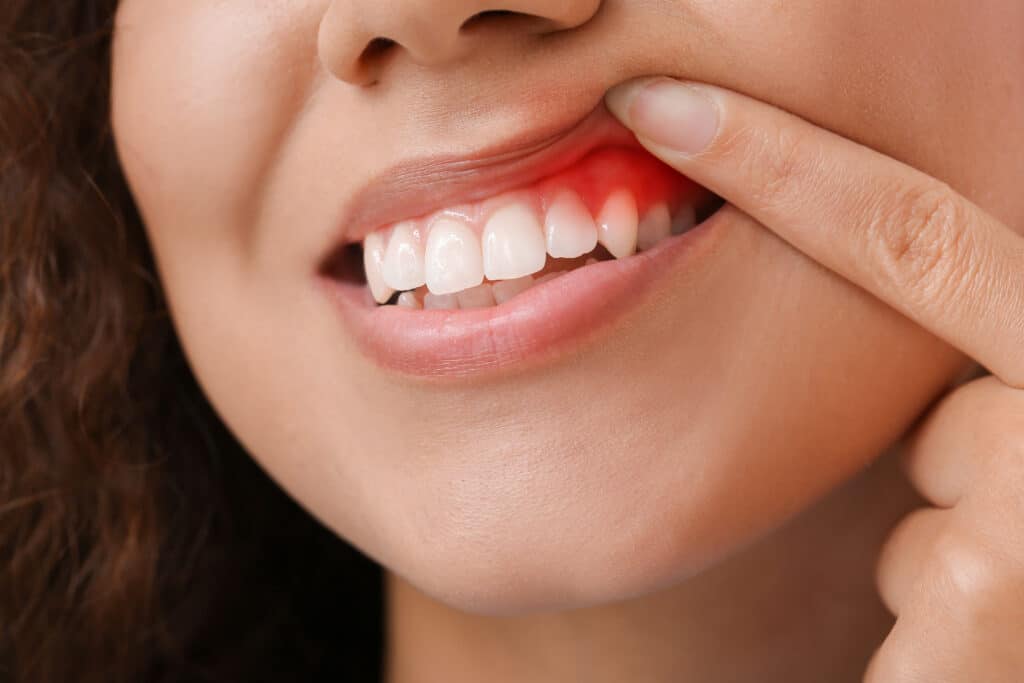
Gingivectomy refers to the removal of diseased tissue such as gingival hyperplasia. Gingivoplasty is performed to reshape healthy gum tissue.
Untreated peridontal diseases can lead to tooth loss.
In the treatment of gingivitis, often just cleaning the tooth surface is sufficient. In cases of periodontitis where there is also a gum pocket, cleaning the root surface under the gum is necessary. Scaling and root planing (SRP- curettage), also known as “initial periodontal treatment,” involves the use of special hand instruments.
If the periodontitis is serious, periodontal surgery may be required, for example flap surgery (also known as pocket reduction surgery) and/or soft or hard tissue grafts.
Proper and regular oral care and routine dental check-ups are the only effective ways to prevent periodontal disease.
Lasers are a great support for gum disease treatment. It is possible to remove the disease living in the space between the roots of the teeth and perform pocket disinfection by using lasers.
Halitosis is an unpleasant breath odour, originating from the mouth or stomach, causing discomfort to both the patient and the people around them. It adversely affects the social life of the patient, leading to self-esteem problems.
The unpleasant breath odour usually originates from the mouth. An intraoral infection, advanced gingival disease or bacteria settled in food remnants left in the mouth for more than a couple of hours, might cause bad breath.
Other systemic problems that might cause bad breath include sinusitis, diabetes (acetone smell), gastrointestinal diseases, kidney failure (fish smell), and liver or metabolic disorders. The root cause of bad breath should first be identified and the treatment should be planned accordingly. Halitosis may be prevented by treating all decays and gingival diseases, extracting the teeth that are indicated for extraction, replacing restorations that require renewal, and increasing the level of oral hygiene.
- Bite, Teeth Grinding (Bruxism) and Joint Problems
Bruxism
Teeth grinding and clenching, bite problems can cause destructive forces that change how you look (aesthetic problems), wear down of teeth, fractures or loss of teeth, and harms your TMJ, jaw, disk and muscles.
Bruxism (teeth grinding) is extraordinary masticatory muscle activity which can occur in during sleep (sleep bruxism) and/or awake states (awake bruxism)
It is characterized by pain in the head&neck region, especially around the temporal muscles and in front of the ear.
Tooth wear, sensitivity and fractures are among the most important clinical symptoms.
Bruxism originated pain can be treated with oral appiliance. These appiliance called splint.
When there is no pain around the head&neck region, just the night guard can be preffered for protection.
Temporamandibular Joint (TMJ) Disorders: Diagnosis and Treatments
The temporomandibular joints (TMJ) are the two joints that connect your lower jaw bone to your skull. The TMJs are the most complex joints in the body.
Temporomandibular disorders are functional disorders that occur as a result of pathologies occurring in biological tissues around the TMJ(such as ligaments, disc and articular component)
Limitation of mouth opening, pain and clicking sound from the joint while chewing are among the primary clinical symptoms.
After clinical and radiographic examinations, patients can be treated by using oral appiliance called splint, which has protective and therapeutic properties
Our TMJ specialist treats a whole range of temporomandibular joint disorders.

